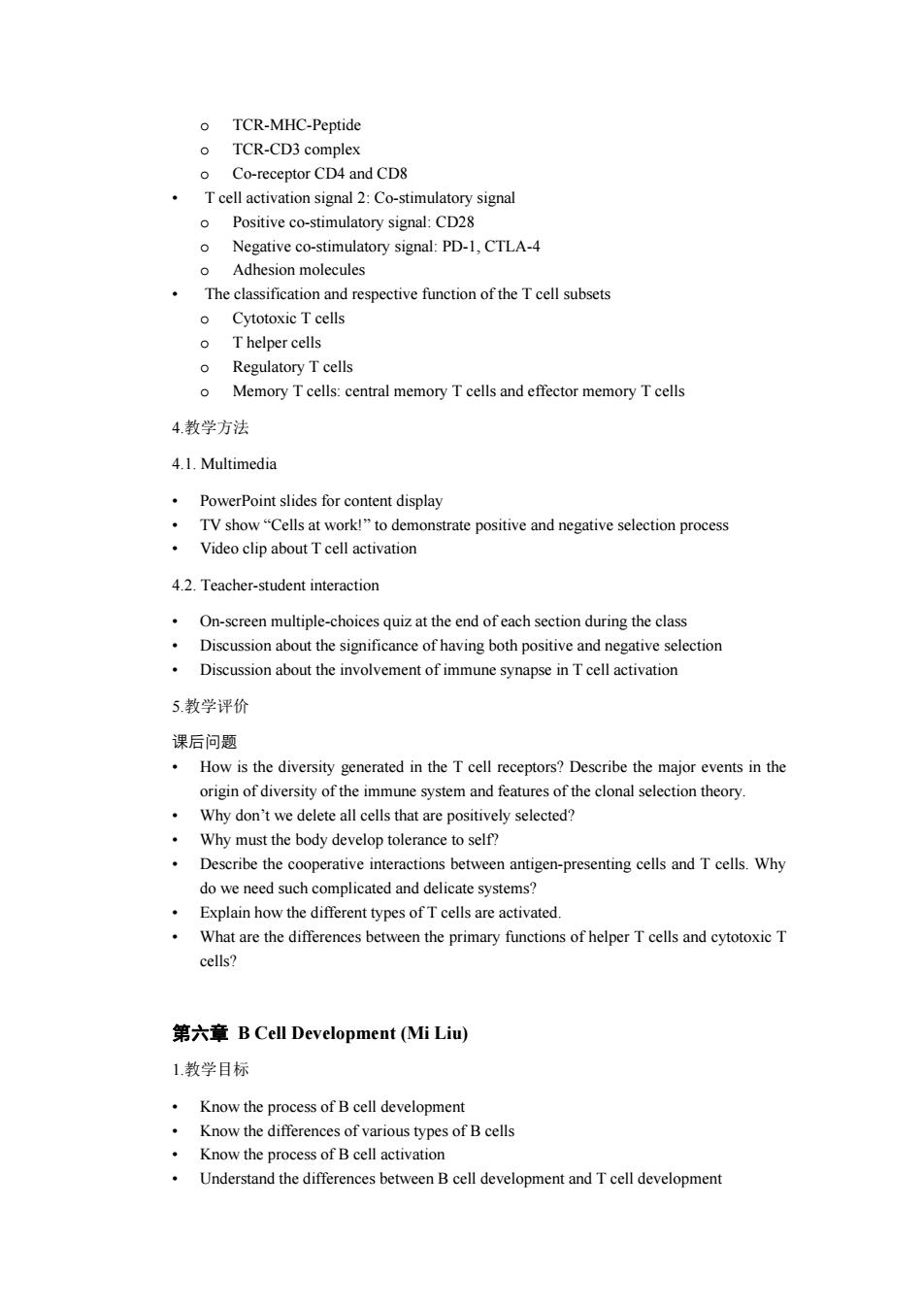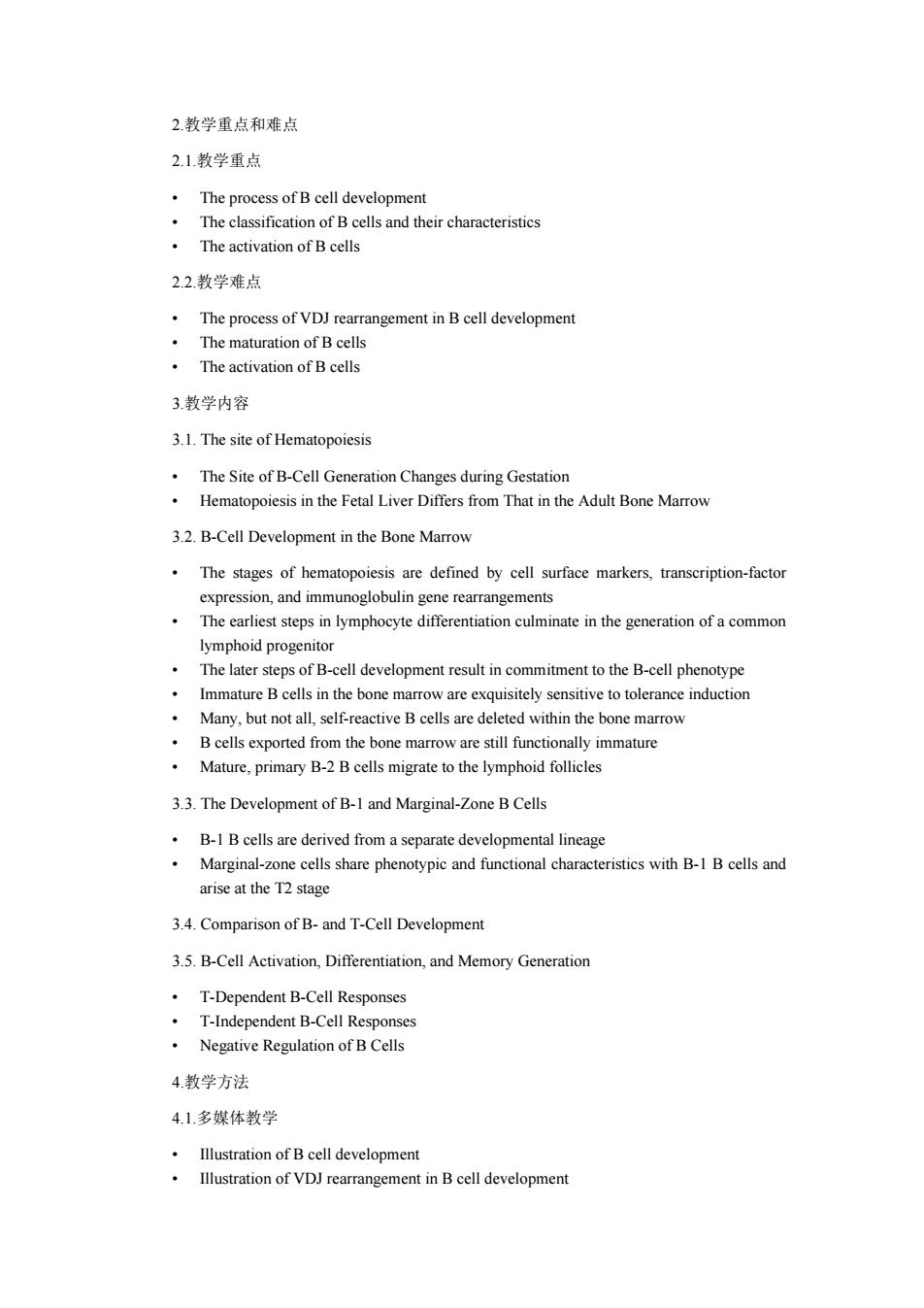
Outline the overall phases in a specific immune response. Summarize the general features of adaptive/acquired immunity.How is adaptive immunity different from innate immunity? Define antigen and immunogen. What are the main categories of antigens based on their chemistry and function? How do shape,size and complexity contribute to antigenicity? What is major histocompatibility complex?Explain how it participates in immune reactions. Why do we need different pathways for antigen presentation? 第五章T cell development,.activation and differentiation(Yiran Zheng 1.教学目标 Know the basic steps involved in the T cell development Know the positive selection and negative selection steps in the T cell development and grasp the significance of having both screening Know signals required for T cell activation and the molecules involved Know the main subsets of T cells and their respective function 2.教学重难点 The mechanism of VDJ recombination Positive selection and negative selection in T cell development.The significance of having both positive selection and negative selection The signals required for T cell activation The collaboration of different molecules involved in the immune synapse for T cell activation 3教学内容 3.1.T cell development Overview of tissues and organs required for T cell development Early thymocyte development The origin of T cell receptor diversity o Multigene organization of Ig Genes o The mechanism of V(D)J recombination o Tcell receptor gene expression Overview of T cell development(double negative stages,double positive stage,single positive stage) Positive selection and its significance Negative selection and its significance The structure of T cell receptor(TCR) Lineage commitment:aBT cells and yT cells 3.2.T cell activation and differentiation T cell activation signal 1:TCR-MHC-peptide signaling
• Outline the overall phases in a specific immune response. • Summarize the general features of adaptive/acquired immunity. How is adaptive immunity different from innate immunity? • Define antigen and immunogen. • What are the main categories of antigens based on their chemistry and function? • How do shape, size and complexity contribute to antigenicity? • What is major histocompatibility complex? Explain how it participates in immune reactions. • Why do we need different pathways for antigen presentation? 第五章 T cell development, activation and differentiation (Yiran Zheng) 1.教学目标 • Know the basic steps involved in the T cell development • Know the positive selection and negative selection steps in the T cell development and grasp the significance of having both screening • Know signals required for T cell activation and the molecules involved • Know the main subsets of T cells and their respective function 2.教学重难点 • The mechanism of VDJ recombination • Positive selection and negative selection in T cell development. The significance of having both positive selection and negative selection • The signals required for T cell activation • The collaboration of different molecules involved in the immune synapse for T cell activation 3.教学内容 3.1. T cell development • Overview of tissues and organs required for T cell development • Early thymocyte development • The origin of T cell receptor diversity o Multigene organization of Ig Genes o The mechanism of V(D)J recombination o T cell receptor gene expression • Overview of T cell development (double negative stages, double positive stage, single positive stage) • Positive selection and its significance • Negative selection and its significance • The structure of T cell receptor (TCR) • Lineage commitment: αβT cells and γδT cells 3.2. T cell activation and differentiation • T cell activation signal 1: TCR-MHC-peptide signaling

o TCR-MHC-Peptide TCR-CD3 complex o Co-receptor CD4 and CD8 T cell activation signal 2:Co-stimulatory signal Positive co-stimulatory signal:CD28 o Negative co-stimulatory signal:PD-1,CTLA-4 0 Adhesion molecules The classification and respective function of the T cell subsets o Cytotoxic T cells o T helper cells Regulatory T cells o Memory T cells:central memory T cells and effector memory T cells 4.教学方法 4.1.Multimedia PowerPoint slides for content display TV show "Cells at work!"to demonstrate positive and negative selection process Video clip about T cell activation 4.2.Teacher-student interaction On-screen multiple-choices quiz at the end of each section during the class Discussion about the significance of having both positive and negative selection Discussion about the involvement of immune synapse in T cell activation 5.教学评价 课后问题 How is the diversity generated in the T cell receptors?Describe the major events in the origin of diversity of the immune system and features of the clonal selection theory Why don't we delete all cells that are positively selected? Why must the body develop tolerance to self? Describe the cooperative interactions between antigen-presenting cells and T cells.Why do we need such complicated and delicate systems? Explain how the different types of T cells are activated. What are the differences between the primary functions of helper T cells and cytotoxic T cells? 第六章B Cell Development(MiLiu) 1.教学日标 Know the process of B cell development Know the differences of various types of B cells Know the process of B cell activation Understand the differences between B cell development and T cell development
o TCR-MHC-Peptide o TCR-CD3 complex o Co-receptor CD4 and CD8 • T cell activation signal 2: Co-stimulatory signal o Positive co-stimulatory signal: CD28 o Negative co-stimulatory signal: PD-1, CTLA-4 o Adhesion molecules • The classification and respective function of the T cell subsets o Cytotoxic T cells o T helper cells o Regulatory T cells o Memory T cells: central memory T cells and effector memory T cells 4.教学方法 4.1. Multimedia • PowerPoint slides for content display • TV show “Cells at work!” to demonstrate positive and negative selection process • Video clip about T cell activation 4.2. Teacher-student interaction • On-screen multiple-choices quiz at the end of each section during the class • Discussion about the significance of having both positive and negative selection • Discussion about the involvement of immune synapse in T cell activation 5.教学评价 课后问题 • How is the diversity generated in the T cell receptors? Describe the major events in the origin of diversity of the immune system and features of the clonal selection theory. • Why don’t we delete all cells that are positively selected? • Why must the body develop tolerance to self? • Describe the cooperative interactions between antigen-presenting cells and T cells. Why do we need such complicated and delicate systems? • Explain how the different types of T cells are activated. • What are the differences between the primary functions of helper T cells and cytotoxic T cells? 第六章 B Cell Development (Mi Liu) 1.教学目标 • Know the process of B cell development • Know the differences of various types of B cells • Know the process of B cell activation • Understand the differences between B cell development and T cell development

2教学重点和难点 2.1.教学重点 The process of B cell development The classification of B cells and their characteristics The activation of B cells 2.2.教学难点 The process of VDJ rearrangement in B cell development The maturation of B cells The activation of B cells 3.教学内容 3.1.The site of Hematopoiesis The Site of B-Cell Generation Changes during Gestation Hematopoiesis in the Fetal Liver Differs from That in the Adult Bone Marrow 3.2.B-Cell Development in the Bone Marrow The stages of hematopoiesis are defined by cell surface markers,transcription-factor expression,and immunoglobulin gene rearrangements The earliest steps in lymphocyte differentiation culminate in the generation of a common lymphoid progenitor The later steps of B-cell development result in commitment to the B-cell phenotype Immature B cells in the bone marrow are exquisitely sensitive to tolerance induction Many,but not all,self-reactive B cells are deleted within the bone marrow B cells exported from the bone marrow are still functionally immature Mature,primary B-2 B cells migrate to the lymphoid follicles 3.3.The Development of B-1 and Marginal-Zone B Cells B-1 B cells are derived from a separate developmental lineage Marginal-zone cells share phenotypic and functional characteristics with B-1 B cells and arise at the T2 stage 3.4.Comparison of B-and T-Cell Development 3.5.B-Cell Activation,Differentiation,and Memory Generation T-Dependent B-Cell Responses T-Independent B-Cell Responses Negative Regulation of B Cells 4教学方法 4.1.多媒体教学 Illustration of B cell development Illustration of VDJ rearrangement in B cell development
2.教学重点和难点 2.1.教学重点 • The process of B cell development • The classification of B cells and their characteristics • The activation of B cells 2.2.教学难点 • The process of VDJ rearrangement in B cell development • The maturation of B cells • The activation of B cells 3.教学内容 3.1. The site of Hematopoiesis • The Site of B-Cell Generation Changes during Gestation • Hematopoiesis in the Fetal Liver Differs from That in the Adult Bone Marrow 3.2. B-Cell Development in the Bone Marrow • The stages of hematopoiesis are defined by cell surface markers, transcription-factor expression, and immunoglobulin gene rearrangements • The earliest steps in lymphocyte differentiation culminate in the generation of a common lymphoid progenitor • The later steps of B-cell development result in commitment to the B-cell phenotype • Immature B cells in the bone marrow are exquisitely sensitive to tolerance induction • Many, but not all, self-reactive B cells are deleted within the bone marrow • B cells exported from the bone marrow are still functionally immature • Mature, primary B-2 B cells migrate to the lymphoid follicles 3.3. The Development of B-1 and Marginal-Zone B Cells • B-1 B cells are derived from a separate developmental lineage • Marginal-zone cells share phenotypic and functional characteristics with B-1 B cells and arise at the T2 stage 3.4. Comparison of B- and T-Cell Development 3.5. B-Cell Activation, Differentiation, and Memory Generation • T-Dependent B-Cell Responses • T-Independent B-Cell Responses • Negative Regulation of B Cells 4.教学方法 4.1.多媒体教学 • Illustration of B cell development • Illustration of VDJ rearrangement in B cell development